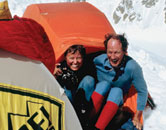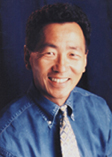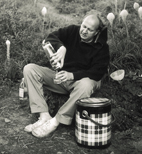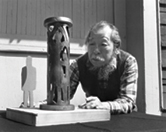Candid and engaging portraits of impactful Northwesterners including Jim Whittaker, mountain climber, and his wife, Dianne Roberts, photographer; Stefani Smith, fisher for crabs IN the Bering Sea; Pat Wright, singer; Dr. Merrill Spencer, inventor of life saving technologies; Scott Oki, former Microsoft marketer, now philanthropist; and Theodore Roethke, poet. Produced under the auspices of Emmy Award-winning filmmaker and groundbreaking television producer Jean Walkinshaw.
Airs Sunday evenings at 7:30pm on SCCtv - Comcast Cable Channel 28, Wave Channel 19 and CenturyLink Channel 8005/HD8505.
During the month of June 2019 SCCtv will broadcast a special hour-long presentation of Remarkable People featuring Jean Walkinshaw beginning at 7pm in honor of Jean Walkinshaw being inducted into the Golden Circle of the Northwest Chapter of the National Academy of Television and Arts Sciences. Jean Walkinshaw's producer/editor Jeff Gentes turned the tables on Jean and created an episode of Remarkable People about Jean. You can also watch this special edition on-demand below.
Jim and Diane Whittaker WATCH

- On the first climb of K2, he had the temerity to take his bride, Dianne who was the only woman on the expedition. This was at a time before women were included in large expeditions to the Himalayas. Dianne frankly recalls her experience which was difficult to say the least. But she proved herself by being the first woman in North America to go to 26,000 feet without bottled oxygen.
- One of the lowest points of Jim's life was when his good friend Robert Kennedy was assassinated. He was at the hospital holding the hands of Teddy and Ethel when Bobby died. At this time, he also went through a painful divorce. A year later, he met his present wife and companion in adventure, Dianne Roberts and was catapulted to a high..
- Jim was the first and only full time employee of the REI. He helped to guide the coop from an $8,000 enterprise to $46 million and later retired from REI. He then got into a bad business deal that caused Jim and Dianne to almost declare bankruptcy. It was at this low point they bought a sail boat and with Dianne and two young teen-age sons, sailed in the south Pacific for four years.
- The documentary is richly visual following Jim's various expeditions. Most of his high mountain Himalayan climbs were filmed by Steve Marts, considered by many to be the best mountain climbing photographer in the world. The South Seas adventures are captured by Dianne, who is also an outstanding photographer.
Stefani Smith WATCH

In this Remarkable People documentary, Stefani points out the importance of Seattle as a base for the Alaska fishery. She questions the extent to which Seattle's Fishermen's Terminal is being taken over by pleasure boats and people who don't understand the culture of fishermen. She laments the fact that few people know how significant fishing was in the early development of Seattle and how important it still is to the economy. Many major fishing companies are based here, fishermen live here off season, buy supplies, and repair their boats in Seattle's machine shops and dry docks.
Stefani is, herself evocative. If you like intensely personal stories with a back drop of stunning photography of the sea, life on board a fishing boat, and of colorful Dutch Harbor and Native Alaskan villages, you will enjoy this program.
- As Stefani from personal experience and with her camera depicts, crab fishing in the Bering Sea is brutal. Constant stormy weather, top heavy boats with iced gear not tied down, men overboard, fierce competition for crabs, and up to thirty six hours of work at a time make this one of the most dangerous professions in the world. Stefani points out that even though there is now a quota allocation, nobody wants to back down. The fishermen still go out in foul weather, and push the envelope to get as large a catch as they can in the shortest time.
- In explaining how she got along living in close quarters with an all-male crew for months at a time, Stefani says, "I denied my female side and hid it as much as I could. I just wanted to do my job. I really loved the WORK". Stefani proved herself to be equal to her male crew members last season, the worst weather since 1991. Freezing spray turned to ice making it impossible to see out the wheel house and causing the boat to become dangerously unstable. The other two crew members had been injured so Stefani alone went out on deck and busted up huge sheets of ice and threw them overboard. In the documentary, with a shy grin, she unassumingly comments, "I always want an excuse to get stronger".
Pat Wright WATCH

- Pat recalls her initial impression of Seattle as she stepped off the bus and experienced the city for the first time. She speaks candidly of social changes that have taken place in the Pacific Northwest and problems that still persist.
- The resounding success of the Total Experience Gospel Choir is touched upon by Pat, who says with a sense of pride, "Every time they'd go out to sing, it was just standing ovation after standing ovation. " The choir has received enthusiastic responses from audiences in 27 countries. For the youth who join the choir, it's been a very positive experience, giving them a sense of belonging and boosting their self-esteem sky-high.
- With her father being a preacher, having married a licensed and ordained minister, and being a minister herself, Pat has a very strong, grounded sense of spirituality that is reflected in both her personal life and her music. While the incredible range of her voice means there are few limits to what she can sing, Pat selects songs that have personal and spiritual meaning for her, from gospel songs to "Bridge Over Troubled Water" and "I Believe I Can Fly."
- Footage from lively performances by Pat and the Total Experience Gospel Choir engage the ears, while still photos from Pat's childhood and of her own family capture her personal life. Her frank opinions are both provocative and inspiring.
Dr. Merrill Spencer WATCH

Program highlights:
- Through principal interviews with Merrill's wife, Joanne, and his stepson, Scott Seidel, the program chronicles Merrill's life form his childhood on an Indian reservation in Oklahoma to his early research with animals at the San Diego Zoo before arriving as a medical researcher IN Seattle. He was, in fact, recruited to be the doctor for Namu, a captive killer whale brought to the Seattle waterfront IN the early 1970s.
- The documentary includes interviews with colleagues including leading cardiologists William Gray and Mark Reisman. "Here was this elderly gentleman, but when you looked into his eyes and listened to him, you felt like you were with a kid," remembers Reisman. "He didn't invent technology for the sake of technology. He truly wanted to help patients and humanity." Observes Dr. Rob Reneman, "His gray cells never stopped working. We wondered what he did at night."
- The program reveals the great importance and lasting influence of Merrill's work. His research and use of Transcranial Dopplera technique for measuring blood flow in the brainis now helping medical science better understand the causes and prevention of stroke and, just recently, migraine headaches. His true impact on the improvement of health care will not be fully known for decades.
Scott Oki WATCH

Program highlights:
- Scott shares recollections of his childhood and family. His core values were largely instilled by his parents, loving but strict Japanese Americans who were married in Minidoka, a World War II internment camp in Idaho. "My father actually decided to serve in the U.S. military at that time," says Scott. "I don't know what I would have donebeing held prisoner behind barbed wire. Imagine the CHARACTER it took."
- Scott talks about the key role that his experience as a Boy Scout played in shaping his life. He participated all the way through high school, reaching the highest standing, as an Eagle Scout. "I still live BY the Scout oath AND laws," he says. "I try AND DO a good turn daily; I try TO be prepared... . Those lessons are AS TRUE today AS WHEN I grew up IN Seattle." In fact, both of Scott's sons are now Eagle Scouts.
- Scott discusses the pivotal time he spent at the Air Force Academy, where he earned an MBA incorporating the emerging field of computersa pursuit that would eventually lead him to the doors of an upstart company called Microsoft.
- "I was LIKE a kid IN a candy store" is how Scott describes his exciting early years at Microsoft. He founded the company's international division, and worldwide sales mushroomed, soon eclipsing domestic sales. During his first three years there, he reveals, he worked seven days a week and never took one day of vacation.
- As Scott shares, marriage and a family finally separated him from the Microsoft world. After his retirement, he dabbled in the golf industry, then went in search of something more meaningful, finding it in philanthropy. He talks about his work with nonprofit organizations around Seattle. Of the more than 100 nonprofits he has worked with, one of the closest to his heart is the Boy Scouts: "IF EVERY kid today had the same experience AS me IN the Boy Scoutsthe VALUES AND lessons learnedsociety's problems would disappear."
Emmett Watson Internet Streaming Not Available

Program highlights:
- The documentary features archival stills and film footage of Emmett and his city dating back to the 1930s, along with a variety of cartoon drawings of Emmett, including a series created especially for the program by Bob McCausland, retired P.-I. editorial artist and longtime friend of Emmett's.
- IN the program, Emmett reflects ON his life AND his career IN print. Speaking about the genesis of his newspaper COLUMN, he says, WITH characteristic humor, "The shift from sports writing to writing about a whole city was somewhat gradual. Some say it roughly paralleled the increase in smog above Seattle." Emmett also READS excerpts FROM his writings, including the book Digressions of a Native Son.
- The program accompanies Emmett ON visits TO SOME of his favorite spots, including Safeco FIELD, Pioneer Square AND Pike Place Market. AT a Mariners baseball game, Emmettwho briefly played WITH the Mariners' predecessors, the Seattle Rainierschats with baseball announcers Dave Niehaus and Rick Rizzs. Also captured are moments from Emmett's annual birthday party AT Seattle's Salumi Restaurant (sadly, the November 2000 celebration marked his last birthday) and a Washington News Council event honoring him.
- Viewers hear about Emmett's early family life, FROM his infancy, WHEN he lost BOTH his parents AND was adopted BY the Watson family, through the Depression, which he says killed his father, a "wonderful, tough, hard-working man."
- Emmett candidly discusses his foibles: "I loved to drink. I drank with friends. I went through treatment later. And I'm clear of it now." Viewers also hear about the evolution of his unofficial "Lesser Seattle" movement, the vocal stand he took AGAINST 1978's anti-gay Initiative 13, and the scoop he got on the circumstances surrounding Ernest Hemingway's death that yielded a story carried around the world.
Theodore Roethke WATCH

- Footage and voice recordings of Roethke discussing his own poetry, his writing process and various inspirations reveal the deeply personal nature of many of his poems. He drew upon "the minutia in life" and personal experiences, keeping note of phrases and thoughts they inspired and later building on and piecing them together into poems.
- Roethke's exuberant teaching style - OR, AS he describes, consisting of energy, noise AND pandemonium - IS praised BY David Wagoner AND other former students FOR his ability TO excite AND LEAVE a LONG-lasting impression. "There aren't very many electrifying teachers like that, but he was one," says Wagoner admiringly.
- Meditative AND FULL of emotion, Beatrice Roethke delicately reveals BOTH the joys of marriage TO Roethke AND the trials of dealing WITH his reoccurring bouts of mania AND depression.
- Striking scenic shots that highlight the beauty AND life IN Roethke's writing accompany the reading of several poems, many done passionately by Roethke himself. As Beatrice Roethke comments, "He responded to the beauty of the state of Washington, particularly to the areas of water."
George Tsutakawa Internet Streaming Not Available

- Capturing Tsutakawa MID-painting, the camera follows his deft brush strokes AND careful blending of water AND ink. He creates many paintings ON the spot, synthesizing the traditional Japanese sumi-e technique WITH his reverence FOR the beauty of nature IN the Pacific Northwest. "The strongest impression I get just living here, like getting up and looking out and seeing Mt. Rainier over there, assures me I'm in God's hands," Tsutakawa says.
- Tsutakawa's fountain designs are partially inspired by the Tibetan ideal of "obos." As Tsutakawa explains, obos is a "concept of perfect harmony of man, heaven and earth [that] creates perfect balance." Footage depicts several of his fountains - spirals, tubes and arcs of metal that are artfully combined to guide the natural flow of water.
- Recollections and thoughts from Tsutakawa's wife Ayame AND four children, Gerard (sculptor), Marcus (music teacher AT Garfield High School), Deems (pianist AND composer of popular music) AND Mayumi (writer) reveal an incredibly CLOSE-knit family WITH an enormous love FOR AND appreciation of the arts. "Art was just the natural thing at the Tsutakawa house," says Marcus.
- Original Emmy-Award winning music played ON the guitar AND shakuhachi floats behind scenic footage FROM Japan AND the Pacific Northwest of snow-capped AND tree-lined mountains, vibrant wild flowers AND tumbling water. Water IS the "element to modulate the tone value" WITH the sumi-e technique, AS well AS "an essential element in our Northwest scene."






